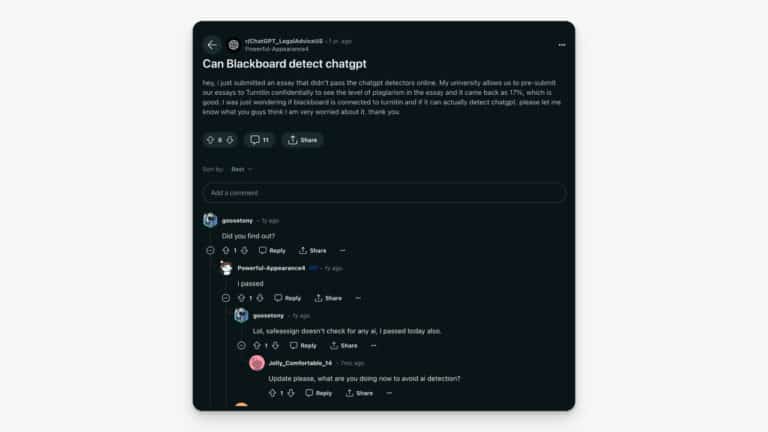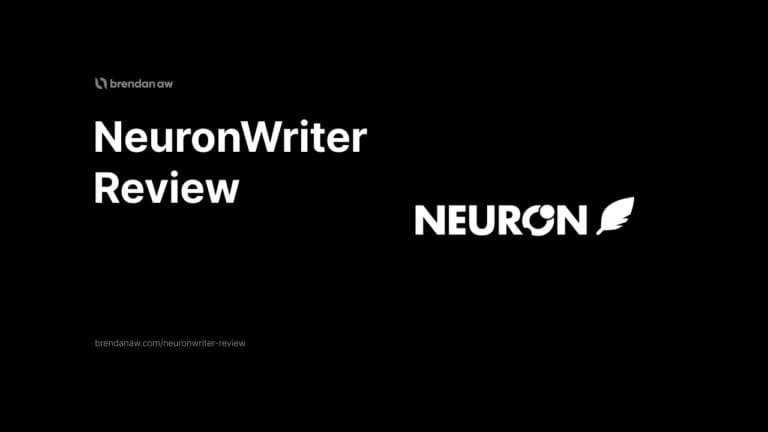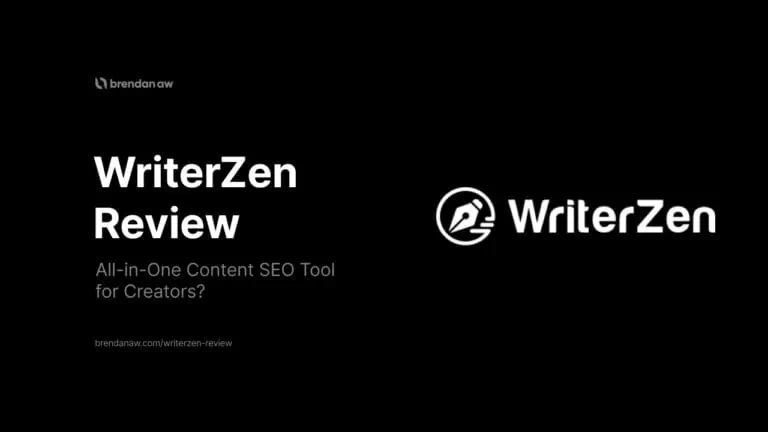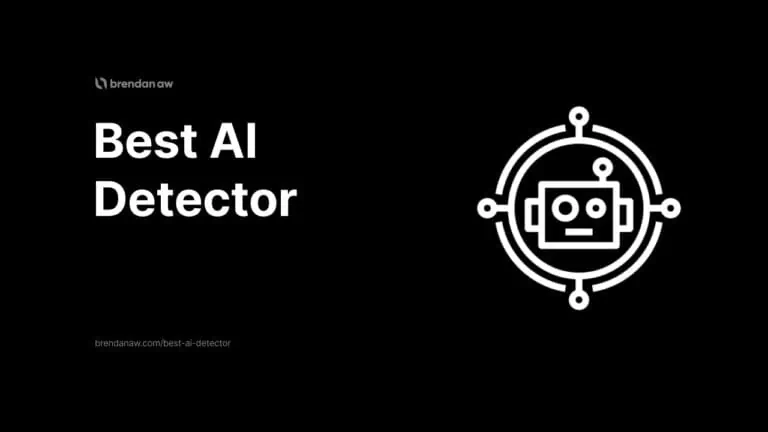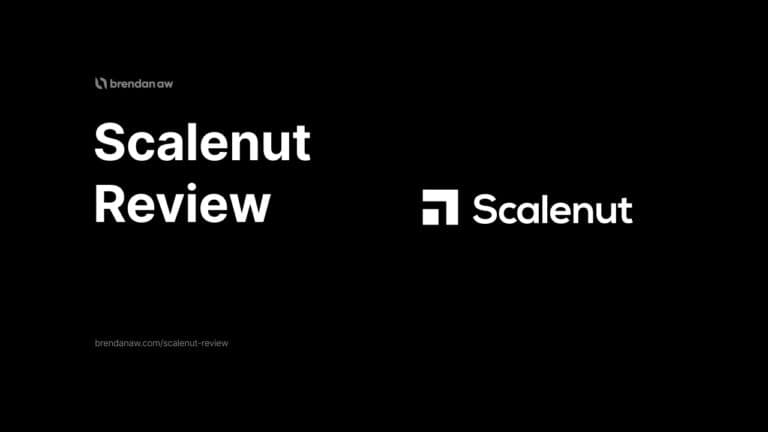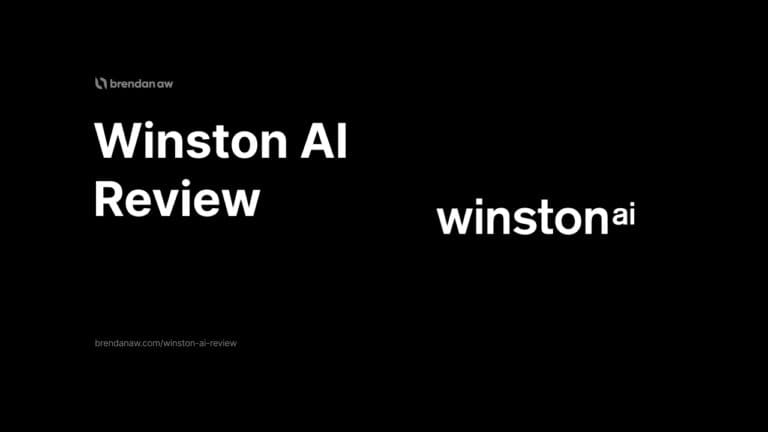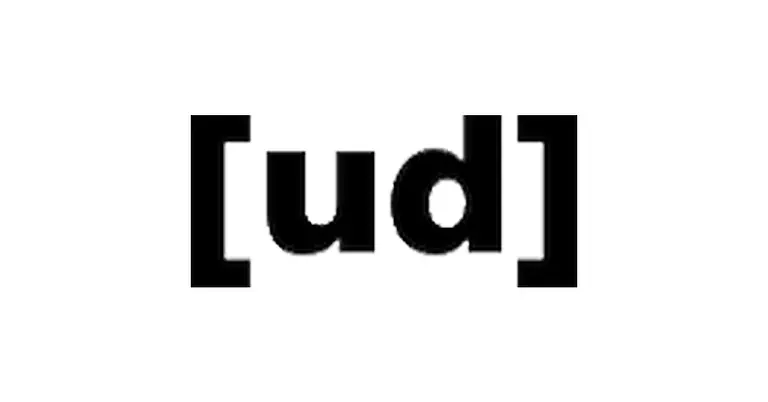Blackboard is a popular online Learning Management System (LMS) in online education.
It’s a virtual classroom where teachers can share materials, assignments, and tests.
Students use it to submit their work, check grades, and communicate with instructors.
But can Blackboard detect ChatGPT?
No, it can’t but let’s dive deeper.
Key Takeaways:
- Blackboard uses SafeAssign to check for plagiarism, not AI content specifically.
- Turnitin and CopyLeaks are additional tools to help detect AI-generated content, offering a stronger defense against ChatGPT.
- I recommend thoroughly editing, proper referencing, and incorporating personal anecdotes to play it safe.
Can Blackboard Detect ChatGPT?
No, Blackboard alone cannot detect ChatGPT.
It uses SafeAssign for plagiarism detection.
It scrutinizes student submissions against a vast database that includes internet sources, prior submissions, and academic papers.
This system spots similarities and potential plagiarism but faces challenges with detecting AI-written texts.
AI algorithms are advancing rapidly, making it harder for systems like Blackboard to catch every instance of AI-generated work.
Despite this, Blackboard integrates AI detectors such as Turnitin and CopyLeaks for more comprehensive scrutiny.
These platforms enhance Blackboard’s capability to detect unusual writing patterns.
However, it remains a complex task as comments from Reddit users seem to suggest that people are still passing.
How Does Blackboard Detect AI?
It doesn’t by itself.
SafeAssign scans billions of internet pages, millions of academic essays, and student papers already submitted.
This huge database helps SafeAssign spot patterns that stand out or look suspicious.
For example, if an essay has a unique phrase seen in an online source but not cited correctly, SafeAssign can flag this as potential plagiarism.
The tool also compares each submission against its library of sources.
It isn’t just looking for copied texts.
It looks for odd matches and paraphrasing that might slip past simpler checks.
This means even cleverly reworded content could get caught if it mirrors the structure or ideas found in known sources too closely.
That’s why it integrates with Turnitin and CopyLeaks.
Limitations Of Blackboard When Detecting ChatGPT
Blackboard struggles to catch all AI-written work, not just ChatGPT because it mainly looks for matches in texts.
Here are some of the main limitations:
Limited Focus on Text Matching
SafeAssign mainly looks at how much student work matches texts from the internet, past submissions, and academic papers.
This method works well for spotting exact copies or very close matches.
But it struggles to catch content that’s cleverly reworded or completely original from AI tools like ChatGPT.
Since these AI tools can write in a unique style, SafeAssign might not see this as plagiarism.
Detecting sophisticated AI paraphrasing is tough for Blackboard.
Tools like ChatGPT craft content that doesn’t directly match anything previously written, slipping past detection systems focused on matching text.
As a result, even with an extensive database of sources, some AI-generated pieces might not raise any red flags because they’re entirely new creations, not found anywhere else online or in databases used by plagiarism detectors.
“Original” AI-Crafted Content
Creating content with AI tools like ChatGPT has become a game-changer for those trying to keep up with the demand for fresh, engaging material.
These tools have evolved, offering hard capabilities to imagine just a few years ago.
Despite its advantages, Blackboard’s current setup can’t detect “original” AI content.
Plagiarism detection tools won’t pick it up because it’s not referenced from an existing database.
But it’s not original because the output is referencing previously trained data.
Yet, the broader challenge remains—ensuring academic integrity while embracing the potential of AI-created works without stifling creativity or penalizing legitimate use.
Limited Databases
SafeAssign, a tool Blackboard uses, has databases with billions of internet pages and millions of academic papers.
It also includes essays students have submitted before.
But these databases don’t catch everything.
They miss content that’s new or not online yet.
AI writing software like ChatGPT is getting smarter.
This means some AI-crafted work will slip through the cracks.
How to Bypass AI Detectors Like CopyLeak and Turnitin?
Bypassing AI detectors like Turnitin and CopyLeak is a tricky business.
Here are some ways I’ve found to work generally well in most situations:
- Write original content: Nothing beats authenticity. It’s hard to flag content that’s genuine and unique. There is still a chance if your natural style is simply robotic.
- Use anecdotes: Adding personal stories or specific examples works great because it wouldn’t have been trained on that data.
- Review language patterns: Ensure your writing doesn’t mimic typical AI-generated structures by reviewing and adjusting sentence patterns.
- Use specialized software: I use Undetectable AI for paraphrasing and Originality AI for further detection. I found this combination to work the best.
- Combine multiple sources: Instead of sticking to one reference or point of view, diversify your research to cover more ground.
- Go beyond top search results: The deeper you go into a topic, the more unique angles you’ll find, making your content less likely to be seen as AI.
These strategies require effort but are a great way to humanize your AI content or make it undetectable.
Can Blackboard Detect ChatGPT (FAQs)
Can Blackboard’s SafeAssign Be Bypassed by ChatGPT Generated Content?
Blackboard’s SafeAssign is designed to detect plagiarism, including some forms of AI-generated content. However, it is not guaranteed to detect all instances of content created by AI writing tools like ChatGPT. SafeAssign checks against a vast database of academic materials as well as internet sources but has some limitations in detecting cleverly generated AI content.
Are There Specific ChatGPT Detectors Being Integrated Into Blackboard To Identify AI-Written Content?
As of now, Blackboard itself does not include a built-in ChatGPT detector. However, it integrates with Turnitin and Copyleaks which do have AI detection capabilities.
How Effective Are Plagiarism Checkers on Blackboard in Identifying AI-Generated Content?
Plagiarism checkers on platforms like Blackboard are effective in catching instances of direct copying and closely paraphrased content from recognized sources. However, the ability to detect AI-generated content specifically remains challenging. While traditional plagiarism checkers are designed to detect content that matches existing sources, AI-generated content that is novel and not directly copied from existing materials may not always be flagged.
Can AI Detection Tools on Blackboard Prevent Students From Cheating Using ChatGPT?
AI detection tools and the platform’s built-in features, like lockdown browsers and plagiarism checkers, can help prevent cheating to a certain extent by detecting unusual patterns or similarities with known sources.
However, these tools might not be able to detect all instances of cheating using ChatGPT or other advanced AI models. It’s important to use these tools in conjunction with other methods of academic integrity verification.
To Sum Up
Blackboard’s journey in detecting ChatGPT isn’t foolproof.
SafeAssign can detect plagiarism while Turnitin and Copyleaks add a dual-layer defense against AI.
However, they do still let some through the cracks.
It’s a constant tug-of-war battle and the future of academia could be threatened if detection can’t keep up.
My best recommendation?
Write it yourself.


